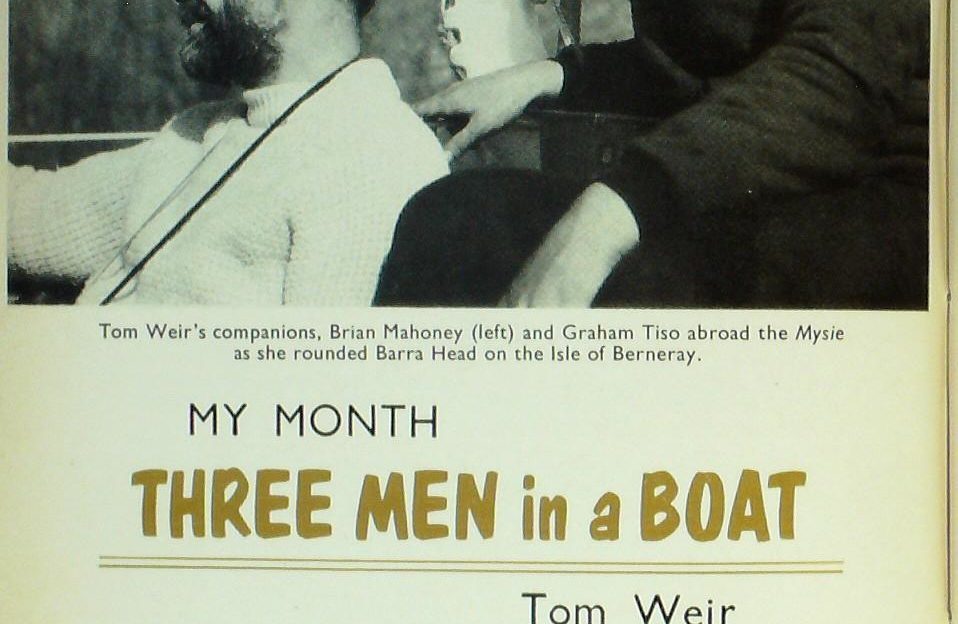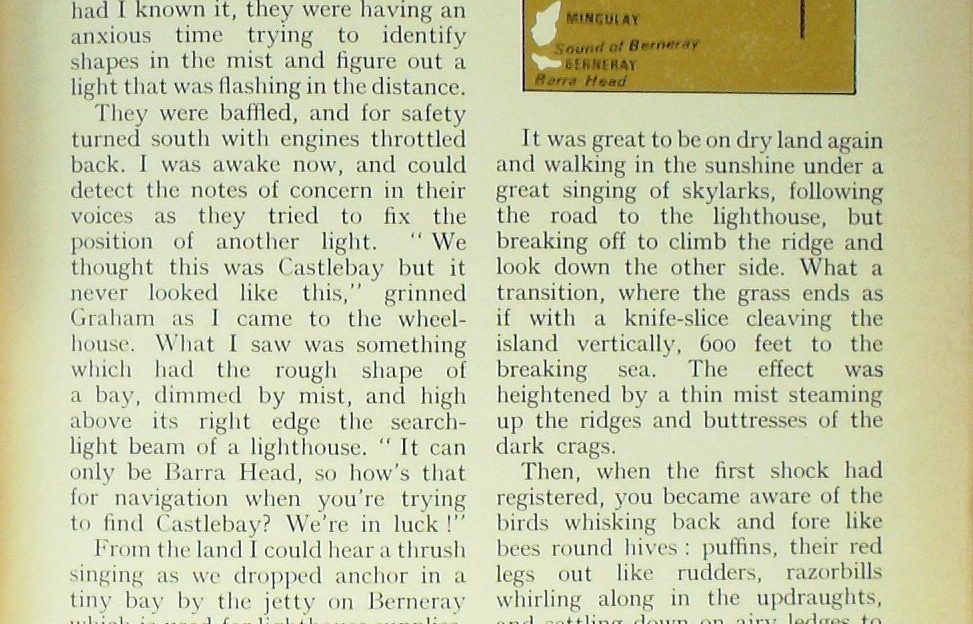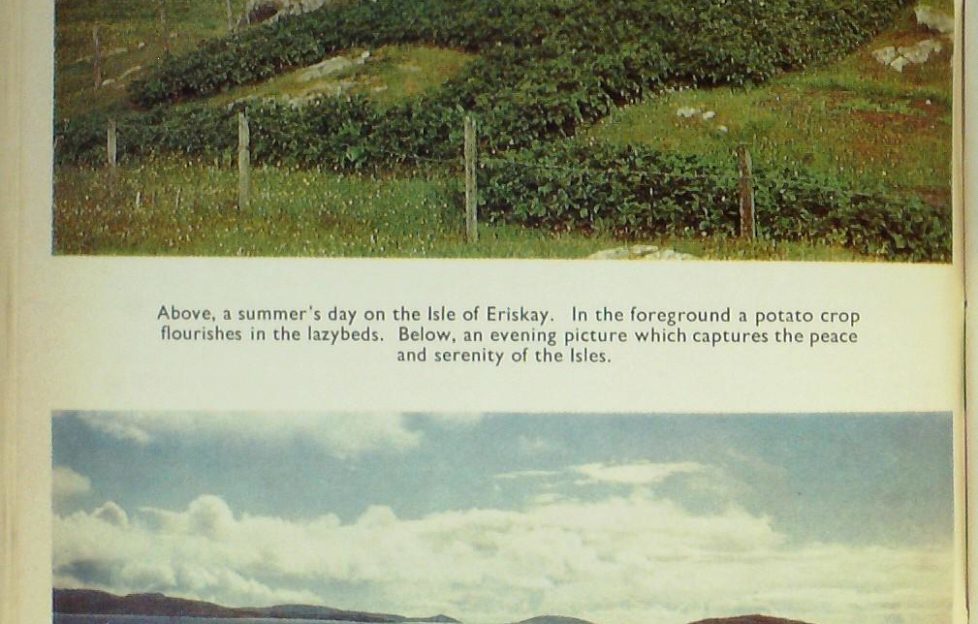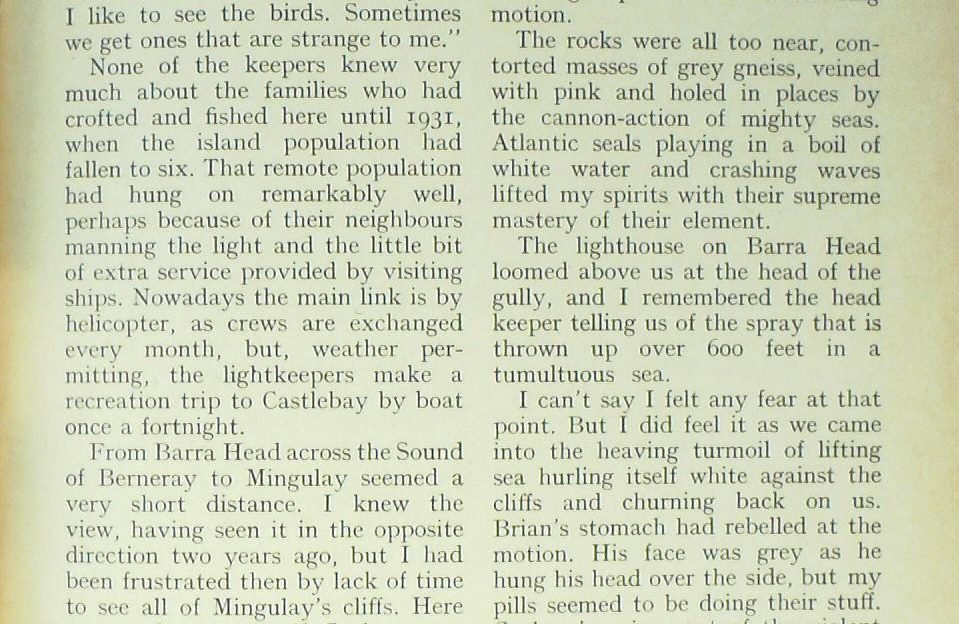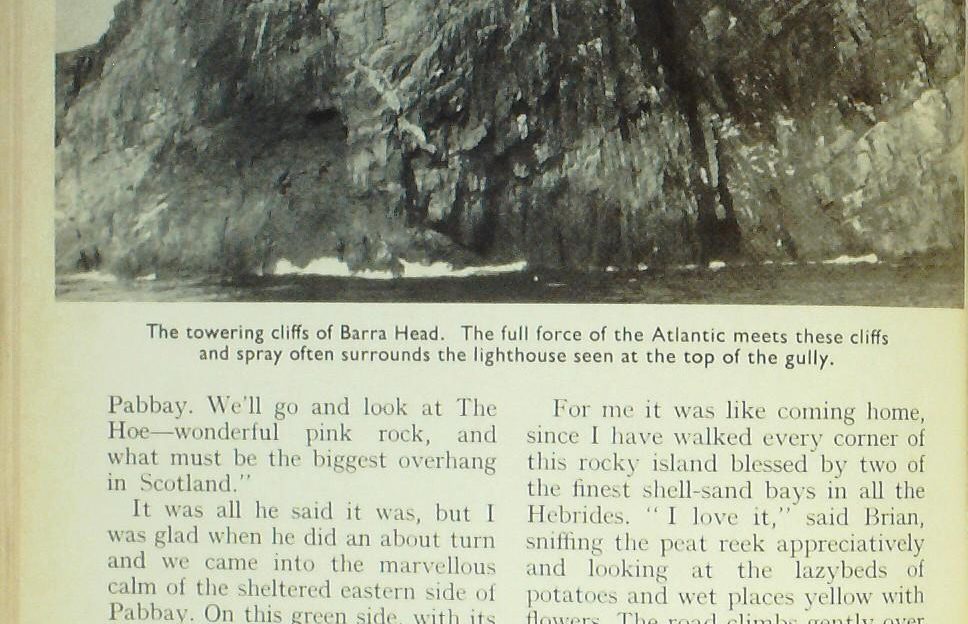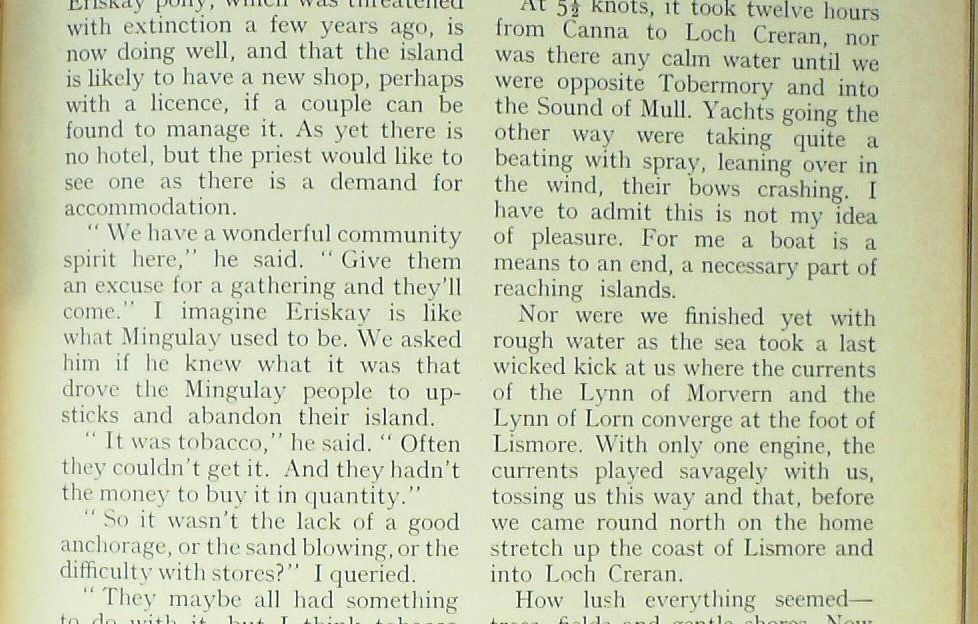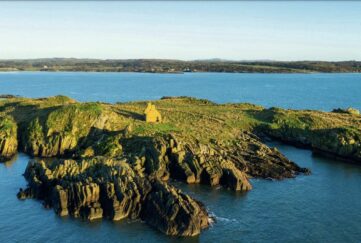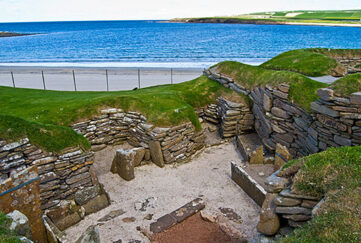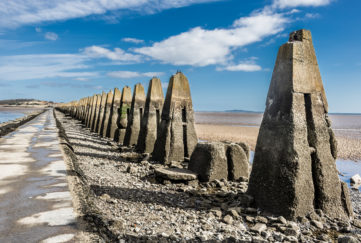Tom Weir | Three Men In A Boat
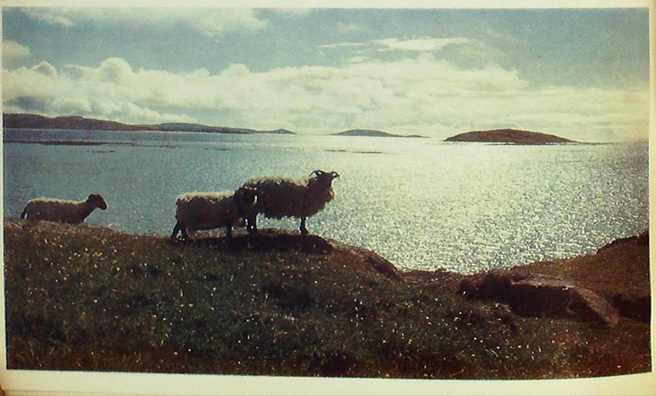
Tom Weir braved the rough and open sea with a couple of friends in order to fully explore the smaller Hebridean isles…
“There’s nothing quite like being on the sea at night in a wee boat,” said Graham. “Nothing lies ahead of us now except the Outer Hebrides. We should be there in another five hours.”
The trim little craft rising and falling in the oily swell was the Mysie, a 36-ft. long “Fifer” ketch with twin Perkins diesel engines which we had fuelled at Oban five hours earlier. Aboard we were three—Graham Tiso, the master; Brian Mahoney, the mate ; and myself, very much the passenger.
I am not a sailor, but a year ago when we went to Scalpay and made landings on the Shiants and Uist (you can read about the voyage here) I had surprised myself by enjoying it all. This time we had a more ambitious ploy to land on Barra Head on the Isle of Berneray and to explore the cliffs of Mingulay.
“a rising moon cast soup-plate reflections on the rippling water…”
Seated in the stern, we looked with satisfaction on the dark headland of Ardnamurchan point behind us, while on the port bow the orange ball of a rising moon cast soup-plate reflections on the rippling water. In the west the sky still held a flush of pink, and around us shearwaters skimmed and guillemots scuttered out of our path.
The shipping forecast had spoken of mist in the Hebrides. It had come true by the time I bunked down, leaving the sailors to sort out the landfall. I had no doubt of their ability, and slept well. Above me, had I known it, they were having an anxious time trying to identify shapes in the mist and figure out a light that was flashing in the distance.
They were baffled, and for safety turned south with engines throttled back. I was awake now, and could detect the notes of concern in their voices as they tried to fix the position of another light. “We thought this was Castlebay but it never looked like this,” grinned Graham as I came to the wheel- house. What I saw was something which had the rough shape of a bay, dimmed by mist, and high above its right edge the searchlight beam of a lighthouse.
“It can only be Barra Mead, so how’s that for navigation when you’re trying to find Castlebay? We’re in luck!”
From the land I could hear a thrush singing as we dropped anchor in a tiny bay by the jetty on Berneray which is used for lighthouse supplies.
Graham and Brian were tired and ready for sleep. Nor was there any stirring until 10 a.m. when the galley got going for a ham and eggs breakfast, then into the dinghy to an island that looked green and inviting in simple plan, a high green ridge sloping to the sea with the ruins of houses and signs of former cultivation in an incipient hollow at mid-height. Incised above the landing, the distance to the lighthouse was marked, one and a quarter miles.
Back on the shore
It was great to be on dry land again and walking in the sunshine under a great singing of skylarks, following the road to the lighthouse, but breaking off to climb the ridge and look down the other side. What a transition, where the grass ends as if with a knife-slice cleaving the island vertically, 600 feet to the breaking sea. The effect was heightened by a thin mist steaming up the ridges and buttresses of the dark crags.
Then, when the first shock had registered, you became aware of the birds whisking back and fore like bees round hives : puffins, their red legs out like rudders, razorbills whirling along in the updraughts, and settling down on airy ledges to perch and look out on the world. Fulmars glided at eye-level with us, and far below, above smooth overhangs polished black by the Atlantic rollers, kittiewakes bugled, mingling their neurotic chorus with the growing “Arr-nr-arr “ of hundreds of guillemots.
Outside of St Kilda I had never seen more puffins, and the razorbills ran them a close second. Two of the keepers were painting the outside top of the lighthouse when we got there. They were James Hunter from Stonehaven, the principal light- keeper, and Alan Chamberlain from Manchester, cheery men both who enjoy their job and are sorry that Barra Head is to go automatic, and that this could be the last season.
Joe Toner from Glasgow, the third keeper, was on cook duty and invited us for coffee.
“We do a month on the light here, and a month in Oban, so we have six months at Barra Head in the year. I like to see the birds. Sometimes we get ones that are strange to me.”
None of the keepers knew very much about the families who had crofted and fished here until 1931, when the island population had fallen to six. That remote population had hung on remarkably well, perhaps because of their neighbours manning the light and the little bit of extra service provided by visiting ships. Nowadays the main link is by helicopter, as crews are exchanged every month, but, weather permitting, the light keepers make a recreation trip to Castlebay by boat once a fortnight.
A bird watcher’s paradise
From Barra Head across the Sound of Berneray to Mingulay seemed a very short distance. I knew the view, having seen it in the opposite direction two years ago, but I had been frustrated then by lack of time to see all of Mingulay’s cliffs. Here was a chance now if Graham was prepared to take the boat in a clockwise circuit round Barra Head and up the west side of Mingulay.
Before doing so, however, we set out east from the lighthouse along the spine of the island to get an idea of its birds. Here is the list I made—buzzard, peregrine, meadow pipit, rock pipit, wren, wheatear, starling, songthrush, collared dove, twite, snipe, skvlark, raven, greater blackbacked gull, kittiwake, razorbill, puffin, guillemot, fulmar.
Back at the boat we had a snack, and I swallowed a couple of seasickness tablets, remembering the rough water I had seen on the American side of Barra Head. Never was any precaution more necessary, for the moment we became exposed to the Atlantic swell the boat began to emulate the Big Dipper. Brian shouted a warning as the boat cork-screwed at a steep angle sideways before diving into the rough and shooting up with a shuddering motion.
The rocks were all too near, contorted masses of grey gneiss, veined with pink and holed in places by the cannon-action of mighty seas. Atlantic seals playing in a boil of white water and crashing waves lifted my spirits with their supreme mastery of their element.
The lighthouse on Barra Head loomed above us at the head of the gully, and I remembered the head keeper telling us of the spray that is thrown up over 600 feet in a tumultuous sea.
I can’t say I felt any fear at that point. But I did feel it as we came into the heaving turmoil of lifting sea hurling itself white against the cliffs and churning back on us. Brian’s stomach had rebelled at the motion. His face was grey as he hung his head over the side, but my pills seemed to be doing their stuff. Graham’s enjoyment of the violent motion, and delight in the wonderfully textured Lewisean gneiss carved into holes and pinnacled into rock-stacks was reassuring. Privately I wondered if the engines of the boat were powerful enough to keep pushing at right angles to the power of the waves surging to the rocks.
Graham took my arm. “Last summer when I was here in the heatwave it was so calm that I sailed right behind the stack on Mingulay. It was marvellous. I landed on Pabbay. We’ll go and look at The Hoe —wonderful pink rock, and what must be the biggest overhang in Scotland.”
It was all he said it was, but I was glad when he did an about turn and we came into the marvellous calm of the sheltered eastern side of Pabbay. On this green side, with its deep bay, are the ruins of houses and signs of cultivation dating from the beginning of the century. The people left, I understand, when an island fishing boat and its crew failed to return.
There is not room here to write of our visits to Yatersay and Barra. I have to jump ahead now to the point where we sailed into the superb natural anchorage on the east side of Eriskay, now with only one engine working.
Back home on Eriskay
For me it was like coming home, since I have walked every corner of this rocky island blessed by two of the finest shell-sand bays in all the Hebrides.
“I love it,” said Brian, smiling the peat reek appreciatively and looking at the lazybeds of potatoes and wet places yellow with flowers. The road climbs gently over the Hanks of Ben Scrien to the settlement where most of the 200 of a population live facing South Uist.
How bright and well-kept the houses looked in their coats of fresh paint! Laughing children answered me in English when I tried out my Gaelic. It was their joke, for everybody uses Gaelic here as a first language. The island priest, Father McNeil, invited us in for coffee and expressed his concern that crofters who leave Eriskav are hanging on to their land when they should be giving it up to those who want to live and work in Eriskay.
“Let them keep the crofthouse as a holiday home. But the land is needed. We have up and coming young fishermen, and we’ll soon be able to crew two more boats. The four boats we have give a living to 24 families. But the young men must have land to build a house and grow potatoes—this is vital.”
I was pleased to hear that the Eriskay pony, which was threatened with extinction a few years ago, is now doing well, and that the island is likely to have a new shop, perhaps with a licence, if a couple can be found to manage it. As yet there is no hotel, but the priest would like to sec one as there is a demand for accommodation.
“We have a wonderful community spirit here,” he said. “Give them an excuse for a gathering and they’ll come.”
I imagine Eriskay is like what Mingulay used to be. We asked him if he knew what it was that drove the Mingulay people to up-sticks and abandon their island.
“It was tobacco,” he said. “Often they couldn’t get it. And they hadn’t the money to buy it in quantity.”
“So it wasn’t the lack of a good anchorage, or the sand blowing, or the difficulty with stores?” I queried.
“They maybe all had something to do with it, but I think tobacco was the catalyst.”
Back at the boat Graham had been doing various maintenance chores, and the weather forecast was gale- force winds in the Hebrides.
“Let’s eat and then head for Canna and a snug anchorage.”
It was a four-hour haul and a rock-and-roll sail in the following wind and rain. The evening was dreary, but we rowed ashore and had a pleasant hour with Br John Lome Campbell and his wife Margaret. Life, I was glad to hear, goes well with them on this volcanic island of 24 people.
The weather, however, was taking a turn…
Visibility was nil, and it was darkening when we reached the boat, but the morning was sparkling for rounding the rock stacks before 9 a.m. The strong to gale-force wind however, was as forecast, and Brian and I declined breakfast as pots rattled in the press and moveable objects slid about. Lying in my bunk, I felt I was going to be tipped on the floor any minute.
At 5.5 knots, it took twelve hours from Canna to Loch Creran, nor was there any calm water until we were opposite Tobermory and into the Sound of Mull. Yachts going the other way were taking quite a beating with spray, leaning over in the wind, their bows crashing. I have to admit this is not my idea of pleasure. For me a boat is a means to an end, a necessary part of reaching islands.
Nor were we finished yet with rough water as the sea took a last wicked kick at 11s where the currents of the Lynn of Morvern and the Lynn of Lorn converge at the foot of Lismore. With only one engine, the currents played savagely with us, tossing us this way and that, before we came round north on the home stretch up the coast of Lismore and into Loch Creran.
How lush everything seemed— trees, fields and gentle shores. Now we made things shipshape, locked the boat, left it on its mooring, and with an outboard engine on the dinghy, puttered to the shore where Graham’s car was parked. He motored us to Oban and set off for Edinburgh, leaving Brian and me to take the road south to Loch Lomond. We were in our respective houses before midnight. Both of us carried a few bruises. They soon faded but not the memories. It was a voyage we’ll all three remember.
We’ll have another column from Tom’s archives next Friday.
Read more…
There’s a great many fascinating columns from Tom Weir in our archives, and we’re slowly republishing them online so that new generations may know them.
Click here to see the online collection.


